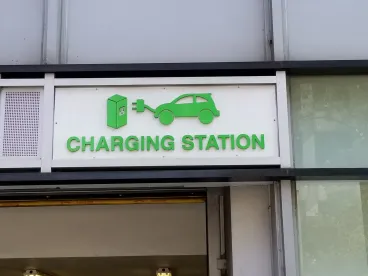On June 9, the Federal Highway Administration (“FHWA”) within the U.S. Department of Transportation (“DOT”) announced a Notice of Proposed Rulemaking (“NPRM”) to establish a set of minimum standards and requirements for electric vehicle (“EV”) charging infrastructure projects funded with federal dollars from the Bipartisan Infrastructure Law (“BIL”). Following the NPRM comment period, which ends 60 days following the publishing of the proposed rule in the Federal Register, a final rulemaking would be a significant step toward standardizing and modernizing what has, to date, been a quilted patchwork of EV charging networks and frustrating customer experiences. The NPRM states its aim is to establish clear rules of the road to create a “convenient, affordable, reliable, and equitable network of chargers” and lower barriers of entry for consumers thinking about going electric for their next vehicle.
Rulemaking is Latest Step Ahead of Billions in EV Funding
The National Electric Vehicle Infrastructure (“NEVI”) Program is a key EV component of the BIL, providing $5 billion in formula funding to states to build out EV charging infrastructure along highway corridors. The BIL provides another $2.5 billion in competitive grants to support charging infrastructure and EV access in underserved and overburdened communities. The Biden Administration aims to deploy such funding (collectively, the “Programs”) to support 500,000 EV chargers in the U.S. by 2030. The BIL required DOT to establish a set of minimum EV standards and requirements for the use of such Programs’ funds within 180 days of the legislation’s enactment. Comments on the proposed rules are due within 60 days of publication in the Federal Register.
The NPRM begins with a detailed recap of the “disparities” in consumer options due to a lack of national standards for EV charging and sets forth various technical, consumer, and reporting requirements across six primary categories:
-
Installation, operation, and maintenance by qualified technicians of EV infrastructure (§ 680.106)
-
Interoperability of EV charging infrastructure (§ 680.108)
-
Traffic control devices and on-premise signs acquired, installed, or operated (§ 680.110)
-
Data requested related to a project funded under the NEVI Formula Program, including the format and schedule for the submission of such data. (§ 680.112)
-
Network connectivity of EV charging infrastructure (§ 680.114)
-
Information on publicly available EV charging infrastructure locations, pricing, real-time availability, and accessibility though mapping applications. (§ 680.116)
Installation and Operation
The NPRM would require each charging station under the NEVI Program to offer a minimum of four Direct Current Fast Charger (“DCFC”) ports capable of simultaneously charging four EVs. Each DCFC port must utilize a Combined Charging System (“CCS”) Type 1 connector and be capable of charging any CCS-compliant vehicle. Each DCFC port would be required to offer charging of at least 150 kilowatts (kW) simultaneously. A J1772 connector would be required for any AC Level 2 chargers. The 150-kW rate is still short of leading networks’ maximum charging capacity (in the range of 250 kW to 350 kW), but it would be a significant improvement if deployed on the national scale that the BIL envisions.
Charging stations would be required to be available for use by the public 24 hours a day, seven days a week, and on a year-round basis, with few exceptions. This would be a welcome standard for current EV drivers that can often be surprised on a road trip that a charging station that appears to be “public” is really in a hotel parking lot restricted to hotel guests, or is located in a parking garage that closes after normal daytime business hours.
In another important step, operators of charging stations could not require memberships for use. Stations would be prohibited from restricting access or service by membership or payment method type. At the same time, contactless payment options would be required and all major debit and credit cards would be accepted. Today, many charging networks require a driver to set up an individual account and login with the network in advance, or risk standing at a charging station feverishly creating a username and unique password in the rain or cold and entering credit card digits. Such accounts can provide some advantages if created in advance and if a driver can rely on a single particular network. But much like the maligned walled gardens of software platforms, this can restrict consumer options. The NPRM would push the consumer experience closer to a typical visit to a gas station where drivers can expect to pull into any station, swipe a credit card, and fill the tank. And where credential-based connectivity and payment is provided, the NPRM requires that charging networks be capable of communicating with other charging networks to enable customers to use a single credential regardless of the charging network responsible for a charging station.
Charging Station Information
Another common frustration for EV drivers is navigating to a charging station only to find that all stalls are occupied, or worse, that certain stalls are inoperable due to malfunctions or broken equipment. This is especially true for EVs manufactured by companies that do not also maintain their own charging network.
Importantly, the NPRM would create a minimum annual uptime requirement of greater than 97% for charging ports. Uptime would be calculated as the time when a charger’s hardware and software are both online and available for use, or in use, and the charging port successfully dispenses electricity as expected. Networks would also be required to provide customers the capability to report outages, malfunctions, or other issues. Charging stations would also be required to make available for third-party software developers real-time data on the status of each charging port and price to charge.
Lastly, the NPRM aims to further enhance pricing transparency by requiring a standardized display of charging costs in $/kWh at charging stations, although the DOT requests public comment on comparable metrics for states where there are restrictions on displaying charges on a $/kWh basis.
Interoperability of EV Charging Infrastructure
The proposed rules require chargers to conform with ISO 15118 for communications with CCS-compliant EVs that have implemented ISO 15118. ISO 15118, developed by the International Electrotechnical Commission and the International Organization for Standardization, would improve network connectivity and support the expanding deployment of emerging capabilities such as smart charge management (allowing for more dynamic responsiveness to EV customers but also grid/utility load management signals) and “Plug and Charge” capabilities that enable a more automated experience connecting an EV to a charger with minimal direct customer action.
Next Steps and Future Rules
In many instances, the NPRM acknowledges the EV sector is still evolving and welcomes feedback from industry and consumers on how to craft appropriate rules that maintain flexibility for further innovation. In addition, the DOT expressly declines to address certain related topics, such as charging station design, whether federal requirements should set different rules for longer-dwell parking locations, such as apartment buildings, or how states should incorporate charging alternatives like battery-swapping business models. The NPRM does not prescribe specific cybersecurity standards, but the proposed rules include a requirement that states implement physical and cybersecurity strategies consistent with their respective State EV Infrastructure Deployment Plans, which must be submitted by August 1st and approved by DOT in order to be eligible to receive NEVI Program funding.
The broad scope of the NPRM could significantly enhance EV charging capacity across the United States as well as harmonize consumer and policymaker expectations for this rapidly-changing sector. As regulators, developers, and financiers of EV infrastructure evaluate the NPRM, the Foley team is at the ready with significant experience, knowledge and expertise related to each element of this transformation, including issues related to the automotive, manufacturing, supply chain, regulatory, IP, private equity, tax equity, project finance, and public-private financing issues.






 />i
/>i

